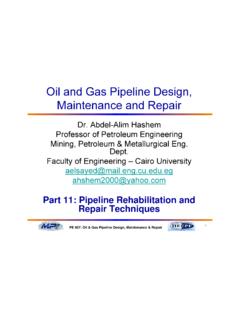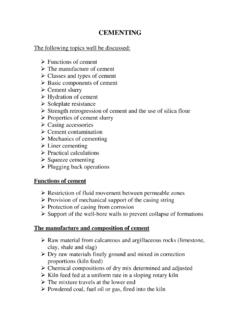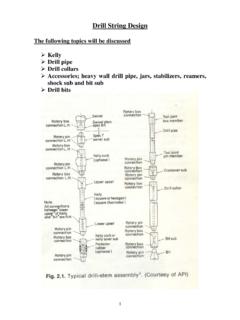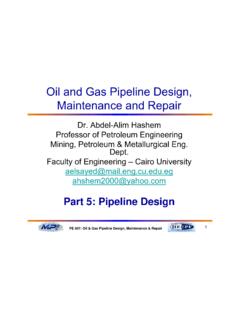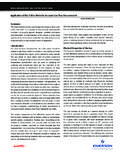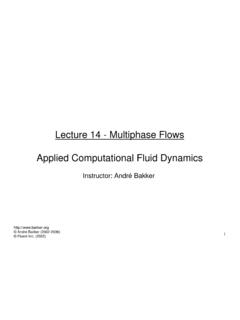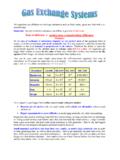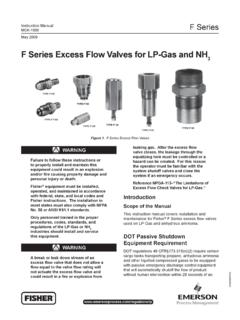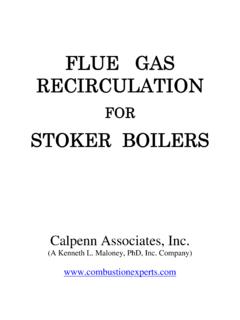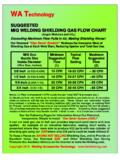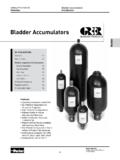Transcription of Oil and Gas Pipeline Design, Maintenance and Repair
1 PE 607: Oil & Gas Pipeline design , Maintenance & RepairDr. Abdel-Alim HashemProfessor of Petroleum Engineering Mining, Petroleum & Metallurgical Eng. Dept. Faculty of Engineering Cairo University 2: Steady-State Flow of Gas through PipesOil and Gas Pipeline design , Maintenance and Repair PE 607: Oil & Gas Pipeline design , Maintenance & RepairINTRODUCTION Pipes provide an economic means of producing and transporting fluids in large volumes over great distances The flow of gases through piping systems involves flow in horizontal, inclined, and vertical orientations, and through constrictions such as chokes for flow control PE 607: Oil & Gas Pipeline design , Maintenance & RepairENERGY OF FLOW OF A FLUID PE 607.
2 Oil & Gas Pipeline design , Maintenance & RepairBERNOULLI'S EQUATION P = the pressure V = the velocity Z = the height Hp= the equivalent head added to the fluid by a compressor at A hf= represents the total frictional pressure loss between points A and B. 2222 AABBApBfPVPVZHZhgg +++ =+++ PE 607: Oil & Gas Pipeline design , Maintenance & RepairVELOCITY OF GAS IN A Pipeline =VQA1112 22=qqMM ==111VV =111 VqA=111 22 bqq qbM ===11bbqq = 1111P=Z RT 1111 PZRT =bbPZRTbb =b111b1bPTZTPZbqq = PE 607: Oil & Gas Pipeline design , Maintenance & RepairVELOCITY OF GAS IN A Pipeline V1 = upstream gas velocity, ft/s qb= gas flow rate, measured at standard conditions, ft3/day (SCFD) d= pipe inside diameter, in.
3 Pb= base pressure, psia Tb= base temperature, R (460 + F) P1= upstream pressure, psia T1= upstream gas temperature, R(460 + F) b111bb1 PTsince == 1b1b1112b1b1ZP4 144 ZPTTTPTP bbqxqVAd == ()TPbqVUSCSd = PE 607: Oil & Gas Pipeline design , Maintenance & RepairVELOCITY OF GAS IN A Pipeline Gas velocity at section 2 is given by Gas velocity at any point in a Pipeline is given = ()TPbqVUSCSd = ()TPbqVSId = PE 607: Oil & Gas Pipeline design , Maintenance & RepairEROSIONAL VELOCITY Vmax= maximum or erosional velocity, ft/s = gas density at flowing temperature, lb/ft3 Z = compressibility factor of gas, dimensionless R = gas constant = ft3psia/lb-moleR T = gas temperature, oR g= gas gravity (air = ) P = gas pressure, psiamax100V =max10029gZRTVP = PE 607: Oil & Gas Pipeline design , Maintenance & RepairExample 1 A gas Pipeline , NPS 20 with in.
4 Wall thickness, transports natural gas (specific gravity = ) at a flow rate of 250 MMSCFD at an inlet temperature of 60 F. Assuming isothermal flow, calculate the velocity of gas at the inlet and outlet of the pipe if the inlet pressure is 1000 psig and the outlet pressure is 850 psig. The base pressure and base temperature are psia and 60 F, respectively. Assume compressibility factor Z = What is the erosional velocity for this Pipeline based on the above data and a compressibility factor Z = PE 607: Oil & Gas Pipeline design , Maintenance & RepairSolution For compressibility factor Z = , the velocity of gas at the inlet pressure of 1000 psig is Gas velocity at the outlet is The erosional velocity is found for Z = , 512250 + + == == ft/s29 PE 607.
5 Oil & Gas Pipeline design , Maintenance & RepairREYNOLD S NUMBER OF FLOW Re= Reynolds number, dimensionless V= average velocity of gas in pipe, ft/s d = inside diameter of pipe, ft = gas density, lb/ft3 = gas viscosity, lb/ft-s()eVdRUSCS = PE 607: Oil & Gas Pipeline design , Maintenance & RepairREYNOLD S NUMBER OF FLOW USCS or SI Re= Reynolds number, dimensionless V= average velocity of gas in pipe, ft/s or m/s d = inside diameter of pipe, ft or m = gas density, lb/ft3or kg/m3 = gas viscosity, ()eVdRUSCS = PE 607: Oil & Gas Pipeline design , Maintenance & RepairREYNOLD S NUMBER OF FLOW IN CUSTOMARY UNITS Pb= base pressure, psia Tb= base temperature, R (460 + F) g= specific gravity of gas (air = ) q = gas flow rate, standard ft3/day (SCFD) d = pipe inside diameter, in.
6 = gas viscosity, ()gbebqPRUSCSTd = PE 607: Oil & Gas Pipeline design , Maintenance & RepairREYNOLD S NUMBER OF FLOW IN CUSTOMARY UNITS Pb= base pressure, kPa Tb= base temperature, K (273 + C) g= specific gravity of gas (air = ) q = gas flow rate, standard m3/day (SCFD) d = pipe inside diameter, mm = gas viscosity, ()gbebqPRSITd = PE 607: Oil & Gas Pipeline design , Maintenance & RepairFlow Regime Re 2000 Laminar flow, 2000 > Re 4000 Critical flow Re > 4000 Turbulent flow PE 607: Oil & Gas Pipeline design , Maintenance & RepairExample A natural gas Pipeline , NPS 20 with in.
7 Wall thickness, transports 100 MMSCFD. The specific gravity of gas is and viscosity is Calculate the value of the Reynolds number of flow. Assume the base temperature and base pressure are 60 F and psia, respectively. PE 607: Oil & Gas Pipeline design , Maintenance & RepairSolution Pipe inside diameter = 20 - 2 x = in. The base temperature = 60 + 460 = 520 R Using Equation we get Since Re is greater than 4000, the flow is in the turbulent 100 , 331, 19exxRx == PE 607: Oil & Gas Pipeline design , Maintenance & RepairFRICTION FACTOR ff= Fanning friction factor fd= Darcy friction factor For laminar flow4dfff=64efR= PE 607: Oil & Gas Pipeline design , Maintenance & RepairFRICTION FACTOR FOR TURBULENT FLOW PE 607.
8 Oil & Gas Pipeline design , Maintenance & RepairINTERNAL ROUGHNESSType of pipe e, in e,mm Drawn tubing (brass, lead, glass) Aluminum pipe Plastic-lined or sand blasted Commercial steel or wrought iron Asphalted cast iron Galvanized iron Cast iron Cement-lined Riveted steel PVC, drawn tubing, glass Concrete Wrought iron Commonly used well tubing and line pipe: New pipe 12-months old 24-months old PE 607: Oil & Gas Pipeline design , Maintenance & RepairTRANSMISSION FACTOR The transmission factor F is related to the friction factor fas follows 2Ff=24fF= PE 607: Oil & Gas Pipeline design , Maintenance & RepairRelative Roughness e = absolute or internal roughness of pipe, in.
9 D = pipe inside diameter, roughness = ed PE 607: Oil & Gas Pipeline design , Maintenance & RepairFLOW EQUATIONS FOR HIGH PRESSURE SYSTEM General Flow equation Colebrook-White equation Modified Colebrook-White equation AGA equation Weymouth equation Panhandle A equation Panhandle B equation IGT equation Spitzglass equation Mueller equation Fritzsche equation PE 607: Oil & Gas Pipeline design , Maintenance & RepairGENERAL FLOW EQUATION (USCS) qsc= gas flow rate, measured at standard conditions, ft3/day (SCFD) f = friction factor, dimensionless Pb= base pressure, psia Tb = base temperature, R( 460 + F) P1= upstream pressure, psia P2= downstream pressure, psia g= gas gravity (air = ) Tav= average gas flowing temperature, R (460 + F) L = pipe segment length, mi Zav= gas compressibility factor at the flowing temperature, dimensionless d = pipe inside diameter, in.
10 () ()bscbgavavPPdTqUSCSPZTfL = PE 607: Oil & Gas Pipeline design , Maintenance & RepairSteady flow in a gas Pipeline PE 607: Oil & Gas Pipeline design , Maintenance & RepairGENERAL FLOW EQUATION (SI) qsc= gas flow rate, measured at standard conditions, m3/day f= friction factor, dimensionless Pb= base pressure, kPa Tb= base temperature, K (273 + C) P1 = upstream pressure, kPa P2 = downstream pressure, kPa g= gas gravity (air = ) Tav= average gas flowing temperature, K (273 + C) L= pipe segment length, km Zav= gas compressibility factor at the flowing temperature, dimensionless d = pipe inside diameter, mm() 10()bscbgavavPPdTqxSIPZTfL = PE 607.
